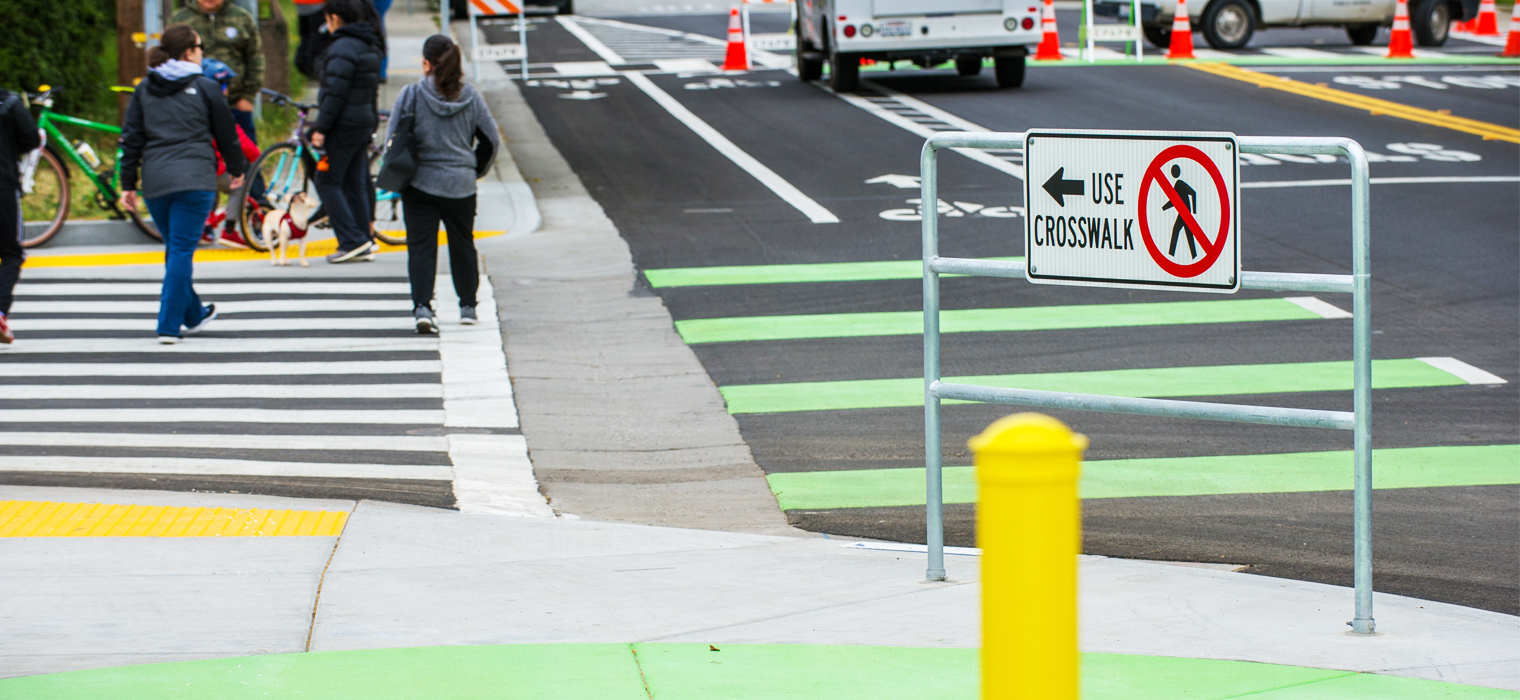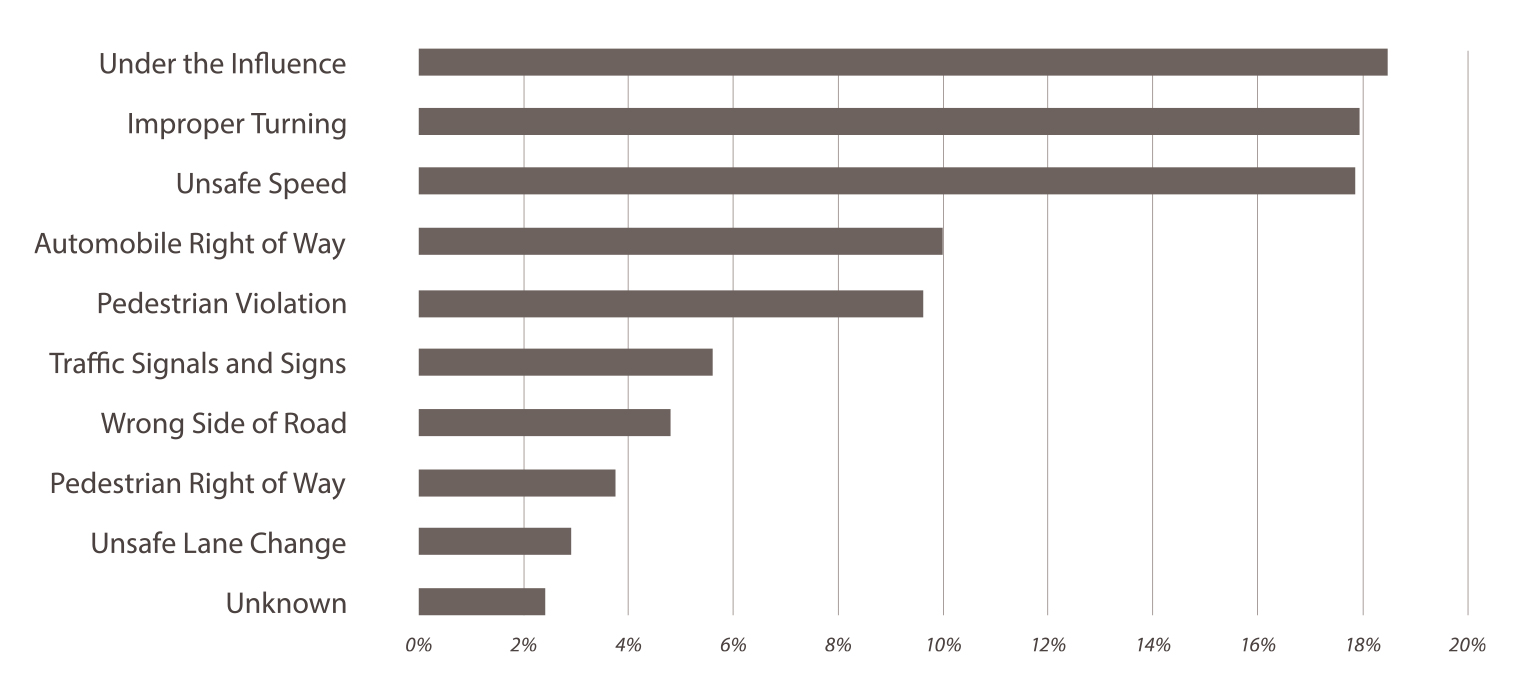Safety Plan Seeks to Protect Roadway Users
Caltrans Joins With Agencies, Partners on Five-Year Strategy

Against a rising trend of roadway fatalities and serious injuries on California roadways, including state highways, since 2010, a consortium of public safety agencies that includes Caltrans has released an updated Strategic Highway Safety Plan with a new urgency to protect travelers.
More than a year in the making, the 2020-2024 Strategic Highway Safety Plan will serve as a road map to improve safety on all public roadways in California. Caltrans was among the agencies and stakeholders that helped draft the plan, and shares responsibility to implement new and upgraded safety measures to reduce fatalities and serious injuries on the State Highway System.
The Strategic Highway Safety Plan for California was introduced in 2005. It’s updated every five years and embraces a goal of reducing the number of traffic-related fatalities and serious injuries in the state to zero by 2050.
The effort comes as California has experienced an overall upswing in the number of people driving, walking and biking who die or sustain serious injuries on the state’s roads. Roadway fatality rates in the state have risen an average of 4 percent since 2010. In 2017, the latest year for which records are available, 3,884 people were killed on California roadways.
Injuries classified as serious jumped 19 percent from 2008 to 2017, when 14,201 persons sustained major injuries from a collision on a California public road. That’s the highest mark in that category so far this century.
Fatal and Serious Injury Collisions by Roadway Ownership and Location

The plan also noted that almost two-thirds of all fatal and serious injury collisions occur on local roadways not owned or maintained by Caltrans. Two-thirds of those collisions happened on urban roads, in incorporated areas with a population of 2,500 or more.
The plan’s collaborators analyzed those and other collision statistics, evaluated progress made from the 2015-2019 plan, and reviewed other statewide and regional plans to develop a statewide safety strategy.
Following in the mold of the 2015-19 plan, current stakeholders identified a list of safety “challenge” areas tied to factors that impact fatality/serious injury collision rates. An implementation plan is now being drafted that outlines specific actions to address these challenge areas.
The 2020-24 plan identifies 16 challenge areas. The implementation plan detailing the planned response to those challenges is being drafted.
For the 2015-19 period, agencies including Caltrans teamed up to tackle 124 actions in the 15 safety challenge areas identified in that plan. The safety partners accomplished or were on track to complete 110 of those 124 assignments by the end of 2019, according to the new plan.
Caltrans, with its roadway operations and maintenance expertise, worked on safety measures based on engineering solutions. Some of the accomplishments in the past five years:
- To reduce roadway departures and head-on collisions, Caltrans has been applying high friction surface treatments to selected roads to helps motorists maintain better control in wet and dry conditions. Almost half of all deaths or serious injuries over a 10-year period ending in 2017 involved lane departures. In addition, the Department is planning to implement 107 relatively low-cost safety measures funded by the federal government as part of Caltrans’ Highway Safety Improvement Program.
- In the area of bicyclist and pedestrian safety, Caltrans regional districts counted available walking and riding resources to create a database, and established methodology to better track that inventory. In addition, Caltrans funded more than 100 safety projects to better protect pedestrians.
- A new Intersectional Control Evaluation workshop was developed to increase the knowledge and skills to evaluate intersections and choose the most effective countermeasures. The Department expects to conduct two workshops per year. Intersections were the site of 20 percent of all road fatalities in the state, and 24 percent of serious injuries from 2008 to 2017, California Highway Patrol data shows.
- Work zone safety for Caltrans workers and contractors has been beefed up, especially important with the increase in the number of projects funded by the Road Repair and Accountability Act (Senate Bill 1). Three new work zone safety initiatives were rolled out in 2019: reducing work-zone speeds, blocking off more space between workers and traffic, and expanding work windows giving crews more flexibility to work safer and get projects done faster.
- To protect motorcyclists, Caltrans has identified locations to incorporate enhanced barrier technology.
Caltrans, the CHP, the Department of Motor Vehicles, and the Office of Traffic Safety, under the umbrella of the California State Transportation Agency, took the lead on many of the roadway safety actions in the last five years, and will do so again to follow through on the 2020-2024 Strategic Highway Safety Plan.
The plan is the product of data accumulation from multiple official sources, and input from more than 300 representatives of state, regional, local federal and tribal governments, as well as advocacy and private organizations.
Fatal and Serious Injury Collisions by Primary Collision Factor

Many Safety Projects Coming in the Next Five Years
With a new strategic highway safety plan in place for the next five years, Caltrans is proposing a slate of work projects to protect travelers and those who work on the state highway system as part of its master construction plan through 2024.
The 2020 State Highway Operation and Protection Program (SHOPP) details how Caltrans plans to preserve and repair the vast highway system, using state transportation revenues projected through the 2023-24 fiscal year. The SHOPP is updated on even-numbered years, and was adopted last month by the California Transportation Commission.
Safety improvement projects constitute a major part of the overall $20 billion spending plan. Of that amount, $2.1 billion is proposed for collision reduction measures on state highways and facilities through 2024. The projects involve:
- Installation of center dividing barriers
- Upgrading guardrails, bridge railing
- Protected bicyclist and pedestrian lanes, and construction of bike/walker facilities
- Crosswalk installation
- Worker protection measures
- Rumble strip placements
- Signalization
- Geometric changes to highway design that lowers collision potential
Safeguarding cyclists and pedestrians, two of the most vulnerable travelers who use the State Highway System, has been a priority for Caltrans. In response to the rise in injuries and deaths among non-motorized users on roads statewide in the last decade, Caltrans identified locations for safety improvement projects. Less extensive pedestrian safety projects have been completed, while larger capital projects are in various stages of planning, design and construction.
In the 2020 SHOPP that lists 920 current and upcoming projects, Caltrans strengthens its commitment to a safe transportation system for all through its Complete Streets initiative. Under Complete Streets, selected state highways that serve as main streets in smaller communities, or arterial streets in suburban or urban communities, are considered for design makeovers that will create safe environments for all road users.
More than 350 Complete Street projects planned for the next five years will feature numerous safety features to protect vehicles, cyclists, walkers and those traveling in transit vehicles.
Safety projects are funded from special reserve in the SHOPP called a reservation. The source of the reservation are the SHOPP and Highway Safety Improvement Program (HSIP), a federal aid program managed by Caltrans that funds infrastructure projects with a goal of significantly lowering the frequency and rate of fatalities and serious injuries on all public roads in California. In fiscal year 2018-19, a total of $639.6 million was committed to fund 221 state and local safety projects, $182 million provided by federal HSIP.
Caltrans is committed to protecting the safety of all road users, particularly the most vulnerable road users such as bicyclists and pedestrians. To demonstrate an increased commitment to traffic safety, the Department recently appointed its first chief safety officer who oversees a team of traffic safety team members.
Source: State Highway System Safety Plan 2020-2024; Sri Balusubramanian, Deputy Division Chief, Caltrans Division of Traffic Operations; Rachel Carpenter, Caltrans Chief Safety Officer.

